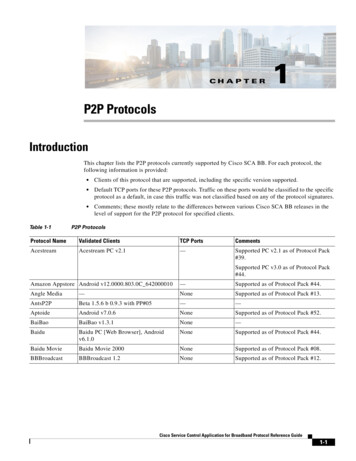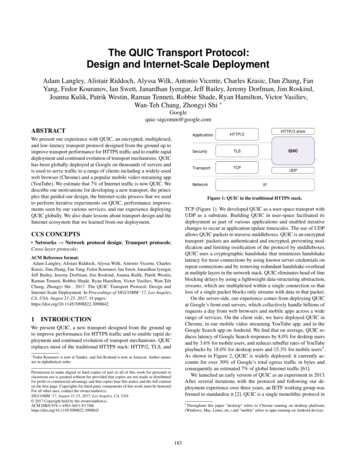
Transcription
The QUIC Transport Protocol:Design and Internet-Scale DeploymentAdam Langley, Alistair Riddoch, Alyssa Wilk, Antonio Vicente, Charles Krasic, Dan Zhang, FanYang, Fedor Kouranov, Ian Swett, Janardhan Iyengar, Jeff Bailey, Jeremy Dorfman, Jim Roskind,Joanna Kulik, Patrik Westin, Raman Tenneti, Robbie Shade, Ryan Hamilton, Victor Vasiliev,Wan-Teh Chang, Zhongyi Shi *Googlequic-sigcomm@google.comABSTRACTWe present our experience with QUIC, an encrypted, multiplexed,and low-latency transport protocol designed from the ground up toimprove transport performance for HTTPS traffic and to enable rapiddeployment and continued evolution of transport mechanisms. QUIChas been globally deployed at Google on thousands of servers andis used to serve traffic to a range of clients including a widely-usedweb browser (Chrome) and a popular mobile video streaming app(YouTube). We estimate that 7% of Internet traffic is now QUIC. Wedescribe our motivations for developing a new transport, the principles that guided our design, the Internet-scale process that we usedto perform iterative experiments on QUIC, performance improvements seen by our various services, and our experience deployingQUIC globally. We also share lessons about transport design and theInternet ecosystem that we learned from our deployment.Figure 1: QUIC in the traditional HTTPS stack.TCP (Figure 1). We developed QUIC as a user-space transport withUDP as a substrate. Building QUIC in user-space facilitated itsdeployment as part of various applications and enabled iterativechanges to occur at application update timescales. The use of UDPallows QUIC packets to traverse middleboxes. QUIC is an encryptedtransport: packets are authenticated and encrypted, preventing modification and limiting ossification of the protocol by middleboxes.QUIC uses a cryptographic handshake that minimizes handshakelatency for most connections by using known server credentials onrepeat connections and by removing redundant handshake-overheadat multiple layers in the network stack. QUIC eliminates head-of-lineblocking delays by using a lightweight data-structuring abstraction,streams, which are multiplexed within a single connection so thatloss of a single packet blocks only streams with data in that packet.On the server-side, our experience comes from deploying QUICat Google’s front-end servers, which collectively handle billions ofrequests a day from web browsers and mobile apps across a widerange of services. On the client side, we have deployed QUIC inChrome, in our mobile video streaming YouTube app, and in theGoogle Search app on Android. We find that on average, QUIC reduces latency of Google Search responses by 8.0% for desktop usersand by 3.6% for mobile users, and reduces rebuffer rates of YouTubeplaybacks by 18.0% for desktop users and 15.3% for mobile users1 .As shown in Figure 2, QUIC is widely deployed: it currently accounts for over 30% of Google’s total egress traffic in bytes andconsequently an estimated 7% of global Internet traffic [61].We launched an early version of QUIC as an experiment in 2013.After several iterations with the protocol and following our deployment experience over three years, an IETF working group wasformed to standardize it [2]. QUIC is a single monolithic protocol inCCS CONCEPTS Networks Network protocol design; Transport protocols;Cross-layer protocols;ACM Reference format:Adam Langley, Alistair Riddoch, Alyssa Wilk, Antonio Vicente, CharlesKrasic, Dan Zhang, Fan Yang, Fedor Kouranov, Ian Swett, Janardhan Iyengar,Jeff Bailey, Jeremy Dorfman, Jim Roskind, Joanna Kulik, Patrik Westin,Raman Tenneti, Robbie Shade, Ryan Hamilton, Victor Vasiliev, Wan-TehChang, Zhongyi Shi . 2017. The QUIC Transport Protocol: Design andInternet-Scale Deployment. In Proceedings of SIGCOMM ’17, Los Angeles,CA, USA, August 21-25, 2017, 14 ODUCTIONWe present QUIC, a new transport designed from the ground upto improve performance for HTTPS traffic and to enable rapid deployment and continued evolution of transport mechanisms. QUICreplaces most of the traditional HTTPS stack: HTTP/2, TLS, and* FedorKouranov is now at Yandex, and Jim Roskind is now at Amazon. Author namesare in alphabetical order.Permission to make digital or hard copies of part or all of this work for personal orclassroom use is granted without fee provided that copies are not made or distributedfor profit or commercial advantage and that copies bear this notice and the full citationon the first page. Copyrights for third-party components of this work must be honored.For all other uses, contact the owner/author(s).SIGCOMM ’17, August 21-25, 2017, Los Angeles, CA, USA 2017 Copyright held by the owner/author(s).ACM ISBN 98822.30988421 Throughoutthis paper "desktop" refers to Chrome running on desktop platforms(Windows, Mac, Linux, etc.) and "mobile" refers to apps running on Android devices.183
SIGCOMM ’17, August 21-25, 2017, Los Angeles, CA, USAA. Langley et al.header, has become fair game for middleboxes to inspect and modify. As a result, even modifying TCP remains challenging due toits ossification by middleboxes [29, 49, 54]. Deploying changes toTCP has reached a point of diminishing returns, where simple protocol changes are now expected to take upwards of a decade to seesignificant deployment (see Section 8).Implementation Entrenchment: As the Internet continues to evolveand as attacks on various parts of the infrastructure (including thetransport) remain a threat, there is a need to be able to deploy changesto clients rapidly. TCP is commonly implemented in the Operating System (OS) kernel. As a result, even if TCP modificationswere deployable, pushing changes to TCP stacks typically requiresOS upgrades. This coupling of the transport implementation to theOS limits deployment velocity of TCP changes; OS upgrades havesystem-wide impact and the upgrade pipelines and mechanisms areappropriately cautious [28]. Even with increasing mobile OS populations that have more rapid upgrade cycles, sizeable user populationsoften end up several years behind. OS upgrades at servers tend tobe faster by an order of magnitude but can still take many monthsbecause of appropriately rigorous stability and performance testingof the entire OS. This limits the deployment and iteration velocityof even simple networking changes.Handshake Delay: The generality of TCP and TLS continues toserve Internet evolution well, but the costs of layering have becomeincreasingly visible with increasing latency demands on the HTTPSstack. TCP connections commonly incur at least one round-trip delayof connection setup time before any application data can be sent,and TLS adds two round trips to this delay2 . While network bandwidth has increased over time, the speed of light remains constant.Most connections on the Internet, and certainly most transactions onthe web, are short transfers and are most impacted by unnecessaryhandshake round trips.Head-of-line Blocking Delay: To reduce latency and overhead costsof using multiple TCP connections, HTTP/1.1 recommends limitingthe number of connections initiated by a client to any server [19].To reduce transaction latency further, HTTP/2 multiplexes multiple objects and recommends using a single TCP connection to anyserver [8]. TCP’s bytestream abstraction, however, prevents applications from controlling the framing of their communications [12] andimposes a "latency tax" on application frames whose delivery mustwait for retransmissions of previously lost TCP segments.In general, the deployment of transport modifications for theweb requires changes to web servers and clients, to the transportstack in server and/or client OSes, and often to intervening middleboxes. Deploying changes to all three components requires incentivizing and coordinating between application developers, OSvendors, middlebox vendors, and the network operators that deploythese middleboxes. QUIC encrypts transport headers and buildstransport functions atop UDP, avoiding dependence on vendors andnetwork operators and moving control of transport deployment tothe applications that directly benefit from them.Figure 2: Timeline showing the percentage of Google traffic served overQUIC. Significant increases and decreases are described in Section 5.1.Figure 3: Increase in secure web traffic to Google’s front-end servers.our current deployment, but IETF standardization will modularizeit into constituent parts. In addition to separating out and specifying the core protocol [33, 34], IETF work will describe an explicitmapping of HTTP on QUIC [9] and separate and replace QUIC’scryptographic handshake with the more recent TLS 1.3 [55, 63].This paper describes pre-IETF QUIC design and deployment. Whiledetails of the protocol will change through IETF deliberation, weexpect its core design and performance to remain unchanged.In this paper, we often interleave our discussions of the protocol,its use in the HTTPS stack, and its implementation. These three aredeeply intertwined in our experience. The paper attempts to reflectthis connectedness without losing clarity.2MOTIVATION: WHY QUIC?Growth in latency-sensitive web services and use of the web as a platform for applications is placing unprecedented demands on reducingweb latency. Web latency remains an impediment to improving userexperience [21, 25], and tail latency remains a hurdle to scaling theweb platform [15]. At the same time, the Internet is rapidly shiftingfrom insecure to secure traffic, which adds delays. As an exampleof a general trend, Figure 3 shows how secure web traffic to Googlehas increased dramatically over a short period of time as serviceshave embraced HTTPS. Efforts to reduce latency in the underlyingtransport mechanisms commonly run into the following fundamentallimitations of the TLS/TCP ecosystem.Protocol Entrenchment: While new transport protocols have beenspecified to meet evolving application demands beyond TCP’s simple service [40, 62], they have not seen wide deployment [49, 52, 58].Middleboxes have accidentally become key control points in the Internet’s architecture: firewalls tend to block anything unfamiliar forsecurity reasons and Network Address Translators (NATs) rewritethe transport header, making both incapable of allowing traffic fromnew transports without adding explicit support for them. Any packetcontent not protected by end-to-end security, such as the TCP packet2 TCPFast Open [11, 53] and TLS 1.3 [55] seek to address this delay, and we discussthem later in Section 8.184
The QUIC Transport Protocol3SIGCOMM ’17, August 21-25, 2017, Los Angeles, CA, USAQUIC DESIGN AND IMPLEMENTATIONthat includes the server’s long-term Diffie-Hellman public value, (ii)a certificate chain authenticating the server, (iii) a signature of theserver config using the private key from the leaf certificate of thechain, and (v) a source-address token: an authenticated-encryptionblock that contains the client’s publicly visible IP address (as seen atthe server) and a timestamp by the server. The client sends this tokenback to the server in later handshakes, demonstrating ownership ofits IP address. Once the client has received a server config, it authenticates the config by verifying the certificate chain and signature.It then sends a complete CHLO, containing the client’s ephemeralDiffie-Hellman public value.Final (and repeat) handshake: All keys for a connection are established using Diffie-Hellman. After sending a complete CHLO,the client is in possession of initial keys for the connection since itcan calculate the shared value from the server’s long-term DiffieHellman public value and its own ephemeral Diffie-Hellman privatekey. At this point, the client is free to start sending application datato the server. Indeed, if it wishes to achieve 0-RTT latency for data,then it must start sending data encrypted with its initial keys beforewaiting for the server’s reply.If the handshake is successful, the server returns a server hello(SHLO) message. This message is encrypted using the initial keys,and contains the server’s ephemeral Diffie-Hellman public value.With the peer’s ephemeral public value in hand, both sides can calculate the final or forward-secure keys for the connection. Uponsending an SHLO message, the server immediately switches to sending packets encrypted with the forward-secure keys. Upon receivingthe SHLO message, the client switches to sending packets encryptedwith the forward-secure keys.QUIC’s cryptography therefore provides two levels of secrecy:initial client data is encrypted using initial keys, and subsequentclient data and all server data are encrypted using forward-securekeys. The initial keys provide protection analogous to TLS sessionresumption with session tickets [60]. The forward-secure keys areephemeral and provide even greater protection.The client caches the server config and source-address token, andon a repeat connection to the same origin, uses them to start theconnection with a complete CHLO. As shown in Figure 4, the clientcan now send initial-key-encrypted data to the server, without havingto wait for a response from the server.Eventually, the source address token or the server config mayexpire, or the server may change certificates, resulting in handshakefailure, even if the client sends a complete CHLO. In this case, theserver replies with a REJ message, just as if the server had receivedan inchoate CHLO and the handshake proceeds from there. Furtherdetails of the QUIC handshake can be found in [43].Version Negotiation: QUIC clients and servers perform versionnegotiation during connection establishment to avoid unnecessarydelays. A QUIC client proposes a version to use for the connectionin the first packet of the connection and encodes the rest of thehandshake using the proposed version. If the server does not speakthe client-chosen version, it forces version negotiation by sendingback a Version Negotiation packet to the client carrying all of theserver’s supported versions, causing a round trip of delay beforeconnection establishment. This mechanism eliminates round-triplatency when the client’s optimistically-chosen version is spokenQUIC is designed to meet several goals [59], including deployability, security, and reduction in handshake and head-of-line blockingdelays. The QUIC protocol combines its cryptographic and transport handshakes to minimize setup RTTs. It multiplexes multiplerequests/responses over a single connection by providing each withits own stream, so that no response can be blocked by another. It encrypts and authenticates packets to avoid tampering by middleboxesand to limit ossification of the protocol. It improves loss recovery byusing unique packet numbers to avoid retransmission ambiguity andby using explicit signaling in ACKs for accurate RTT measurements.It allows connections to migrate across IP address changes by using a Connection ID to identify connections instead of the IP/port5-tuple. It provides flow control to limit the amount of data bufferedat a slow receiver and ensures that a single stream does not consumeall the receiver’s buffer by using per-stream flow control limits. Ourimplementation provides a modular congestion control interface forexperimenting with various controllers. Our clients and servers negotiate the use of the protocol without additional latency. This sectionoutlines these elements in QUIC’s design and implementation. Wedo not describe the wire format in detail in this paper, but insteadrefer the reader to the evolving IETF specification [2].3.1Connection EstablishmentFigure 4: Timeline of QUIC’s initial 1-RTT handshake, a subsequentsuccessful 0-RTT handshake, and a failed 0-RTT handshake.QUIC relies on a combined cryptographic and transport handshake for setting up a secure transport connection. On a successfulhandshake, a client caches information about the origin3 . On subsequent connections to the same origin, the client can establish anencrypted connection with no additional round trips and data canbe sent immediately following the client handshake packet without waiting for a reply from the server. QUIC provides a dedicatedreliable stream (streams are described below) for performing thecryptographic handshake. This section summarizes the mechanics ofQUIC’s cryptographic handshake and how it facilitates a zero roundtrip time (0-RTT) connection setup. Figure 4 shows a schematic ofthe handshake.Initial handshake: Initially, the client has no information about theserver and so, before a handshake can be attempted, the client sendsan inchoate client hello (CHLO) message to the server to elicit areject (REJ) message. The REJ message contains: (i) a server config3 Anorigin is identified by the set of URI scheme, hostname, and port number [5].185
SIGCOMM ’17, August 21-25, 2017, Los Angeles, CA, USAA. Langley et al.by the server, and incentivizes servers to not lag behind clientsin deployment of newer versions. To prevent downgrade attacks,the initial version requested by the client and the list of versionssupported by the server are both fed into the key-derivation functionat both the client and the server while generating the final keys.3.2Stream MultiplexingApplications commonly multiplex units of data within TCP’s singlebytestream abstraction. To avoid head-of-line blocking due to TCP’ssequential delivery, QUIC supports multiple streams within a connection, ensuring that a lost UDP packet only impacts those streamswhose data was carried in that packet. Subsequent data received onother streams can continue to be reassembled and delivered to theapplication.QUIC streams are a lightweight abstraction that provide a reliablebidirectional bytestream. Streams can be used for framing application messages of arbitrary size—up to 264 bytes can be transferred ona single stream—but they are lightweight enough that when sendinga series of small messages a new stream can reasonably be used foreach one. Streams are identified by stream IDs, which are staticallyallocated as odd IDs for client-initiated streams and even IDs forserver-initiated streams to avoid collisions. Stream creation is implicit when sending the first bytes on an as-yet unused stream, andstream closing is indicated to the peer by setting a "FIN" bit on thelast stream frame. If either the sender or the receiver determines thatthe data on a stream is no longer needed, then the stream can becanceled without having to tear down the entire QUIC connection.Though streams are reliable abstractions, QUIC does not retransmitdata for a stream that has been canceled.A QUIC packet is composed of a common header followed by oneor more frames, as shown in Figure 5. QUIC stream multiplexing isimplemented by encapsulating stream data in one or more streamframes, and a single QUIC packet can carry stream frames frommultiple streams.The rate at which a QUIC endpoint can send data will alwaysbe limited (see Sections 3.5 and 3.6). An endpoint must decidehow to divide available bandwidth between multiple streams. In ourimplementation, QUIC simply relies on HTTP/2 stream priorities [8]to schedule writes.3.3Figure 5: Structure of a QUIC packet, as of version 35 of Google’sQUIC implementation. Red is the authenticated but unencrypted public header, green indicates the encrypted body. This packet structure isevolving as QUIC gets standardized at the IETF [2].endpoints use the packet number as a per-packet nonce, which isnecessary to authenticate and decrypt packets. The packet number isplaced outside of encryption cover to support decryption of packetsreceived out of order, similar to DTLS [56].Any information sent in unencrypted handshake packets, such asin the Version Negotiation packet, is included in the derivation ofthe final connection keys. In-network tampering of these handshakepackets causes the final connection keys to be different at the peers,causing the connection to eventually fail without successful decryption of any application data by either peer. Reset packets are sentby a server that does not have state for the connection, which mayhappen due to a routing change or due to a server restart. As a result,the server does not have the connection’s keys, and reset packets aresent unencrypted and unauthenticated5 .3.4Loss RecoveryTCP sequence numbers facilitate reliability and represent the orderin which bytes are to be delivered at the receiver. This conflationcauses the "retransmission ambiguity" problem, since a retransmitted TCP segment carries the same sequence numbers as the original packet [39, 64]. The receiver of a TCP ACK cannot determinewhether the ACK was sent for the original transmission or for aretransmission, and the loss of a retransmitted segment is commonlydetected via an expensive timeout. Each QUIC packet carries a newpacket number, including those carrying retransmitted data. Thisdesign obviates the need for a separate mechanism to distinguish theACK of a retransmission from that of an original transmission, thusavoiding TCP’s retransmission ambiguity problem. Stream offsetsin stream frames are used for delivery ordering, separating the twofunctions that TCP conflates. The packet number represents an explicit time-ordering, which enables simpler and more accurate lossdetection than in TCP.QUIC acknowledgments explicitly encode the delay between thereceipt of a packet and its acknowledgment being sent. Together withmonotonically-increasing packet numbers, this allows for preciseAuthentication and EncryptionWith the exception of a few early handshake packets and reset packets, QUIC packets are fully authenticated and mostly encrypted.Figure 5 illustrates the structure of a QUIC packet. The parts of theQUIC packet header outside the cover of encryption are requiredeither for routing or for decrypting the packet: Flags, Connection ID,Version Number, Diversification Nonce, and Packet Number4 . Flagsencode the presence of the Connection ID field and length of thePacket Number field, and must be visible to read subsequent fields.The Connection ID serves routing and identification purposes; it isused by load balancers to direct the connection’s traffic to the rightserver and by the server to locate connection state. The version number and diversification nonce fields are only present in early packets.The server generates the diversification nonce and sends it to theclient in the SHLO packet to add entropy into key generation. Both5 QUICconnections are susceptible to off-path third-party reset packets with spoofedsource addresses that terminate the connection. IETF work will address this issue.4 The details of which fields are visible may change during QUIC’s IETF standardization.186
The QUIC Transport ProtocolSIGCOMM ’17, August 21-25, 2017, Los Angeles, CA, USAnetwork round-trip time (RTT) estimation, which aids in loss detection. Accurate RTT estimation can also aid delay-sensing congestioncontrollers such as BBR [10] and PCC [16]. QUIC’s acknowledgments support up to 256 ACK blocks, making QUIC more resilientto reordering and loss than TCP with SACK [46]. Consequently,QUIC can keep more bytes on the wire in the presence of reorderingor loss.These differences between QUIC and TCP allowed us to buildsimpler and more effective mechanisms for QUIC. We omit furthermechanism details in this paper and direct the interested reader tothe Internet-draft on QUIC loss detection [33].3.5IP and port. Such changes can be caused by NAT timeout and rebinding (which tend to be more aggressive for UDP than for TCP [27])or by the client changing network connectivity to a new IP address.While QUIC endpoints simply elide the problem of NAT rebindingby using the Connection ID to identify connections, client-initiatedconnection migration is a work in progress with limited deploymentat this point.3.8Flow ControlWhen an application reads data slowly from QUIC’s receive buffers,flow control limits the buffer size that the receiver must maintain. A slowly draining stream can consume the entire connection’s receive buffer, blocking the sender from sending data onother streams. QUIC ameliorates this potential head-of-line blocking among streams by limiting the buffer that a single stream canconsume. QUIC thus employs connection-level flow control, whichlimits the aggregate buffer that a sender can consume at the receiveracross all streams, and stream-level flow control, which limits thebuffer that a sender can consume on any given stream.Similar to HTTP/2 [8], QUIC employs credit-based flow-control.A QUIC receiver advertises the absolute byte offset within eachstream up to which the receiver is willing to receive data. As datais sent, received, and delivered on a particular stream, the receiverperiodically sends window update frames that increase the advertisedoffset limit for that stream, allowing the peer to send more data onthat stream. Connection-level flow control works in the same wayas stream-level flow control, but the bytes delivered and the highestreceived offset are aggregated across all streams.Our implementation uses a connection-level window that is substantially larger than the stream-level window, to allow multipleconcurrent streams to make progress. Our implementation also usesflow control window auto-tuning analogous to common TCP implementations (see [1] for details.)3.63.9Open-Source ImplementationOur implementation of QUIC is available as part of the open-sourceChromium project [1]. This implementation is shared code, usedby Chrome and other clients such as YouTube, and also by Googleservers albeit with additional Google-internal hooks and protections.The source code is in C , and includes substantial unit and end-toend testing. The implementation includes a test server and a testclient which can be used for experimentation, but are not tuned forproduction-level performance.4EXPERIMENTATION FRAMEWORKOur development of the QUIC protocol relies heavily on continual Internet-scale experimentation to examine the value of variousfeatures and to tune parameters. In this section we describe the experimentation frameworks in Chrome and our server fleet, whichallow us to experiment safely with QUIC.We drove QUIC experimentation by implementing it in Chrome,which has a strong experimentation and analysis framework thatallows new features to be A/B tested and evaluated before fulllaunch. Chrome’s experimentation framework pseudo-randomly assigns clients to experiments and exports a wide range of metrics,from HTTP error rates to transport handshake latency. Clients thatare opted into statistics gathering report their statistics along witha list of their assigned experiments, which subsequently enables usto slice metrics by experiment. This framework also allows us torapidly disable any experiment, thus protecting users from problematic experiments.We used this framework to help evolve QUIC rapidly, steering itsdesign according to continuous feedback based on data collected atthe full scale of Chrome’s deployment. Monitoring a broad array ofmetrics makes it possible to guard against regressions and to avoidCongestion ControlThe QUIC protocol does not rely on a specific congestion controlalgorithm and our implementation has a pluggable interface to allow experimentation. In our deployment, TCP and QUIC both useCubic [26] as the congestion controller, with one difference worthnoting. For video playback on both desktop and mobile devices, ournon-QUIC clients use two TCP connections to the video server tofetch video and audio data. The connections are not designated as audio or video connections; each chunk of audio and video arbitrarilyuses one of the two connections. Since the audio and video streamsare sent over two streams in a single QUIC connection, QUIC usesa variant of mulTCP [14] for Cubic during the congestion avoidancephase to attain parity in flow-fairness with the use of TCP.3.7QUIC Discovery for HTTPSA client does not know a priori whether a given server speaks QUIC.When our client makes an HTTP request to an origin for the first time,it sends the request over TLS/TCP. Our servers advertise QUIC support by including an "Alt-Svc" header in their HTTP responses [48].This header tells a client that connections to the origin may be attempted using QUIC. The client can now attempt to use QUIC insubsequent requests to the same origin.On a subsequent HTTP request to the same origin, the clientraces a QUIC and a TLS/TCP connection, but prefers the QUICconnection by delaying connecting via TLS/TCP by up to 300 ms.Whichever protocol successfully establishes a connection first endsup getting used for that request. If QUIC is blocked on the path, orif the QUIC handshake packet is larger than the path’s MTU, thenthe QUIC handshake fails, and the client uses the fallback TLS/TCPconnection.NAT Rebinding and Connection MigrationQUIC connections are identified by a 64-bit Connection ID. QUIC’sConnection ID enables connections to survive changes to the client’s187
SIGCOMM ’17, August 21-25, 2017, Los Angeles, CA, USAA. Langley et al.imposing undue risks that might otherwise result from rapid evolution. As discussed in Section 5, this framework allowed us to containthe impact of the occasional mistake. Perhaps more importantly andunprecedented for a transport, QUIC had the luxury of being able todirectly link experiments into analytics of the application servicesusing those connections. For instance, QUIC experimental resultsmight be presented in terms of familiar metrics for a transport, suchas packet retransmission rate, but the results were also quantifiedby user- and application-centric performance metrics, such as websearch response times or rebuffer rate for video playbacks. Throughsmall but repeatable improvements and rapid iteration, the QUICproject has been able to establish and sustain an appreciable andsteady trajectory of cumulative pe
The QUIC Transport Protocol SIGCOMM ’17, August 21-25, 2017, Los Angeles, CA



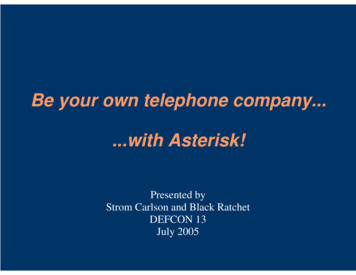
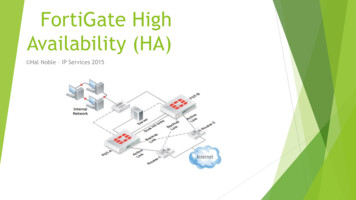

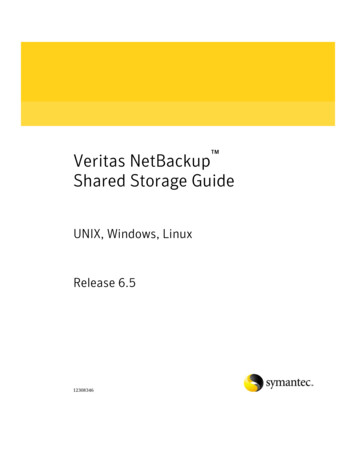

![[MS-FASOD]: File Access Services Protocols Overview](/img/10/5bms-fasod-5d.jpg)
![[MS-OFBA]: Office Forms Based Authentication Protocol](/img/3/ms-ofba.jpg)
